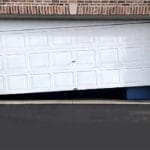To remove door rust from your home, sand the rusted area and apply a rust converter. Finally, repaint for protection.
Rust can be an unsightly and damaging issue for doors in your home. Addressing it promptly helps maintain the door’s appearance and functionality. Rust forms when metal is exposed to moisture and oxygen over time. This can weaken the door’s structure and lead to further problems.

Removing rust involves a few simple steps. You’ll need sandpaper, a rust converter, and paint. By sanding away the rust, applying the converter, and repainting the door, you can restore its look and extend its life. This guide will walk you through each step to ensure your doors remain rust-free and durable.
Identifying Door Rust
Rust can weaken your door, making it look bad. It’s important to spot rust early. Early detection can save you money and time. Let’s look at how to identify door rust.
Common Rust Signs
Rust usually shows up as reddish-brown spots. These spots can spread quickly. Look for these common signs:
- Discoloration: Rust changes the door’s color.
- Flaking paint: Rust makes paint bubble and peel.
- Rough texture: Rusty areas feel rough to touch.
- Holes or pits: Advanced rust eats through metal.
Tools For Inspection
To find rust, you need some simple tools. Here are the tools you will need:
| Tool | Purpose |
|---|---|
| Flashlight | To see hidden rust spots. |
| Magnifying glass | To look closely at small spots. |
| Gloves | To protect your hands. |
| Scraper | To check for loose paint. |
Use these tools to inspect your door. Start by shining the flashlight on all parts of the door. Then, use the magnifying glass to look at any spots that concern you. Wear gloves to protect your hands. Finally, use a scraper to check for loose paint. This will help you find rust hiding under the paint.
Preparing For Rust Removal
Removing rust from your door can seem daunting. But with the right preparation, it becomes manageable. Proper preparation ensures safety and effectiveness. Let’s dive into what you need to get started.
Safety Gear
Before you start, prioritize your safety. Rust removal involves chemicals and tools. So, wearing the right safety gear is crucial.
- Gloves: Protect your hands from chemicals and sharp edges.
- Safety Goggles: Shield your eyes from dust and debris.
- Face Mask: Prevent inhalation of harmful particles.
- Protective Clothing: Wear long sleeves and pants to cover your skin.
Gathering Supplies
Having all the necessary supplies beforehand saves time. Here is a list of what you’ll need:
| Supplies | Purpose |
|---|---|
| Sandpaper | To scrub away loose rust. |
| Rust Remover | To dissolve rust effectively. |
| Wire Brush | To reach into nooks and crannies. |
| Clean Rags | To wipe away rust and debris. |
| Primer and Paint | To protect the door from future rust. |
Ensure all supplies are within reach. This makes the process smoother and more efficient.
Cleaning The Affected Area
Removing door rust requires a clean surface. Proper cleaning is essential. It ensures effective rust removal and prevents further damage. This section explains the best methods for cleaning the affected area.
Surface Cleaning Methods
Start by wiping the door with a dry cloth. This removes loose dirt and debris. Next, use a scrub brush to clean the rusted area. A wire brush works best for stubborn rust spots. Scrub gently to avoid damaging the door surface.
For detailed cleaning, use sandpaper. Sand the rusted area until smooth. Choose fine-grit sandpaper for a smoother finish. Wipe away dust with a damp cloth after sanding. This prepares the door for the next steps.
Degreasing Techniques
Degreasing is crucial for thorough cleaning. Grease and oil can hinder rust removal. Use a commercial degreaser for best results. Spray the degreaser on the affected area. Let it sit for a few minutes.
Scrub the area with a brush. This removes grease and oil. Rinse with clean water and dry with a cloth. Make sure the area is completely dry before proceeding.
A homemade degreaser can also be effective. Mix equal parts of baking soda and water. Apply the paste to the rusted area. Let it sit for 10 minutes. Scrub and rinse as mentioned above.
| Tool | Usage |
|---|---|
| Dry Cloth | Remove loose dirt and debris |
| Wire Brush | Scrub stubborn rust spots |
| Sandpaper | Smooth the rusted area |
| Commercial Degreaser | Remove grease and oil |
| Baking Soda Paste | Alternative homemade degreaser |
- Wipe the door with a dry cloth
- Scrub rust with a wire brush
- Sand the area with fine-grit sandpaper
- Use a commercial degreaser
- Try a baking soda paste as a homemade option
Removing Rust Mechanically
Removing rust from doors can make your home look better. One effective way is by removing rust mechanically. This method involves physical actions to remove rust. It is an efficient and straightforward process. Let’s dive into some techniques.
Sanding Techniques
Sanding is a common way to remove rust. You can use sandpaper or a sanding block. Here’s a simple guide:
- Start with coarse-grit sandpaper (60-80 grit).
- Rub the sandpaper on the rusty spot in a circular motion.
- Gradually switch to finer grit (120-150 grit) for smoothness.
- Wipe the area with a clean cloth to remove dust.
Repeat these steps until all rust is gone. Always wear a mask to protect from dust.
Using A Wire Brush
A wire brush is another great tool for rust removal. It can reach tight spots easily. Follow these steps:
- Choose a wire brush with strong bristles.
- Scrub the rusty area firmly.
- Use short, quick strokes for better results.
- After scrubbing, wipe the area with a damp cloth.
Wire brushes work well on larger, flat surfaces. They are useful for heavy rust too.
Both sanding and wire brushing are effective. They help in restoring your door’s look. Now, you can choose the best method for your door.
Chemical Rust Removal
Rust on doors can be unsightly and damaging. Chemical rust removal offers an effective solution. This method uses specific chemicals to dissolve and remove rust. Below, we explore different types of rust removers and their application methods.
Types Of Rust Removers
There are various types of rust removers available in the market:
- Oxalic Acid: Effective for light rust. Safe for most surfaces.
- Phosphoric Acid: Converts rust into a black, stable compound.
- Hydrochloric Acid: Strong acid, best for heavy rust. Requires caution.
- Chelating Agents: Eco-friendly and safe. Works slower than acids.
- Commercial Rust Removers: Pre-mixed solutions. Easy to use.
Application Methods
Applying rust removers correctly ensures effective results. Here are the steps:
- Clean the door: Remove dirt and debris with a damp cloth.
- Apply the rust remover: Follow the manufacturer’s instructions.
- Wait for the reaction: Allow the remover to work for the recommended time.
- Scrub the rust: Use a brush to scrub away the dissolved rust.
- Rinse and dry: Rinse the area with water and dry it completely.
Here is a table summarizing the types of rust removers and their uses:
| Type of Rust Remover | Best For | Precautions |
|---|---|---|
| Oxalic Acid | Light rust | Wear gloves, avoid inhaling |
| Phosphoric Acid | Medium rust | Use in a well-ventilated area |
| Hydrochloric Acid | Heavy rust | Requires protective gear |
| Chelating Agents | Environmentally safe option | Works slower |
| Commercial Rust Removers | Easy to use | Follow product instructions |
Preventing Future Rust
Once you’ve removed the rust from your doors, it’s essential to prevent it from coming back. This section will guide you through effective methods to keep your doors rust-free.
Protective Coatings
Applying a protective coating can significantly extend the life of your door.
- Paint: Choose rust-resistant paint for metal doors.
- Sealant: Use a sealant for wooden doors to prevent moisture.
- Wax: Apply wax to metal surfaces for an extra layer of protection.
| Coating Type | Ideal For | Application Frequency |
|---|---|---|
| Rust-Resistant Paint | Metal Doors | Every 3-5 Years |
| Sealant | Wooden Doors | Every 2-3 Years |
| Wax | Metal Surfaces | Twice a Year |
Regular Maintenance Tips
Regular maintenance can keep rust at bay. Follow these tips for best results:
- Inspect Regularly: Check your doors monthly for signs of rust.
- Clean Frequently: Wipe down doors to remove dirt and moisture.
- Lubricate Hinges: Apply oil to hinges to prevent rust buildup.
- Reapply Coatings: Reapply protective coatings as needed.
By following these steps, you can keep your doors in excellent condition. Regular care and protective measures can save you from costly repairs.
Repairing Rust Damage
Rust can damage your door. It can create holes and weak spots. Fixing this damage can help your door last longer. This section will guide you through the steps.
Filling Holes
First, clean the rusty area. Remove all loose rust and paint. Use a wire brush or sandpaper. Make sure the surface is smooth.
Next, apply a rust converter. This stops the rust from spreading. Let it dry completely.
Now, fill the holes with epoxy filler. Mix the filler according to the instructions. Apply it with a putty knife. Smooth it out so it’s level with the door surface.
After it dries, sand the area again. This makes the surface smooth and ready for painting.
Repainting Tips
Start by applying a primer. Choose one made for metal surfaces. This helps the paint stick and prevents rust.
Once the primer is dry, paint the door. Use a rust-resistant paint for best results. Apply two coats for better coverage. Let each coat dry completely before adding the next.
Finally, check your work. Make sure the paint is smooth and even. This will make your door look new and protect it from future rust.
Professional Help
Removing door rust can be tricky. Sometimes, you need professional help. Experts have the right tools and skills. Let’s explore when to call an expert and cost considerations.
When To Call An Expert
Minor rust spots can be fixed at home. But extensive rust damage needs an expert. Call a professional if you see these signs:
- Rust covers a large area.
- The door’s structure is compromised.
- Repeated rust problems.
- Rust on intricate or delicate parts.
Professionals will use advanced methods. They ensure thorough rust removal. They also help prevent future rust problems.
Cost Considerations
Hiring a professional can be costly. But it saves time and ensures quality work. Here’s a simple breakdown of potential costs:
| Service | Average Cost |
|---|---|
| Inspection | $50 – $100 |
| Rust Removal | $100 – $300 |
| Door Replacement | $200 – $500 |
Costs depend on door material and damage extent. Get quotes from multiple professionals. Compare their prices and services. Investing in professional help can save future repair costs.
Frequently Asked Questions
How To Remove Your Own Door Rust?
To remove door rust, sand the rusted area, apply rust converter, and then paint over it with rust-resistant paint.
How To Get Rust Off An Exterior Door?
To remove rust from an exterior door, scrub with a wire brush. Apply a rust remover, then rinse and dry.
How To Clean An Oxidized Metal Door?
Clean an oxidized metal door by scrubbing with a mixture of vinegar and water. Rinse thoroughly and dry. Apply a metal polish to restore shine.
How To Pick Up Door Rust?
To pick up door rust, use a wire brush to scrub off loose rust. Apply a rust converter, then paint.
How Do You Remove Rust From A Door?
Use white vinegar, baking soda, or a commercial rust remover to scrub off the rust.
Conclusion
Removing door rust from your home is simpler than it seems. Follow these steps to restore your doors’ appearance. Regular maintenance helps prevent future rust formation. Invest in quality materials and protective coatings. Keep your home looking fresh and inviting by addressing rust issues promptly.
Your doors will thank you.




